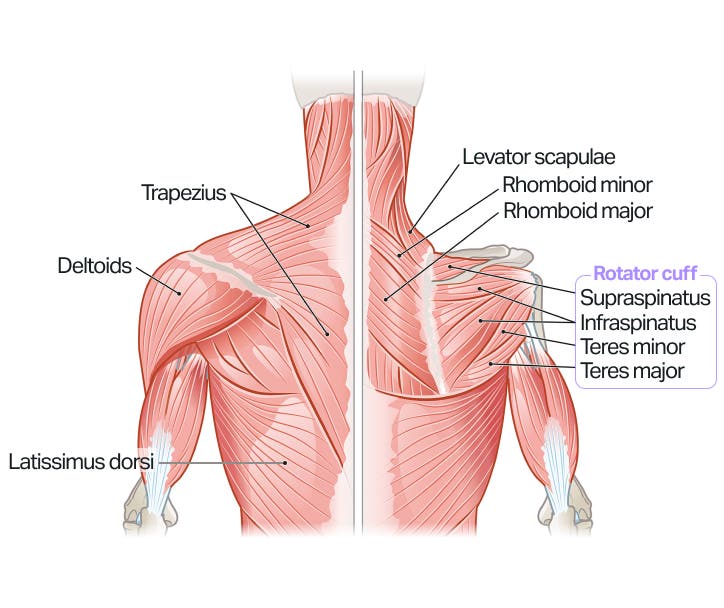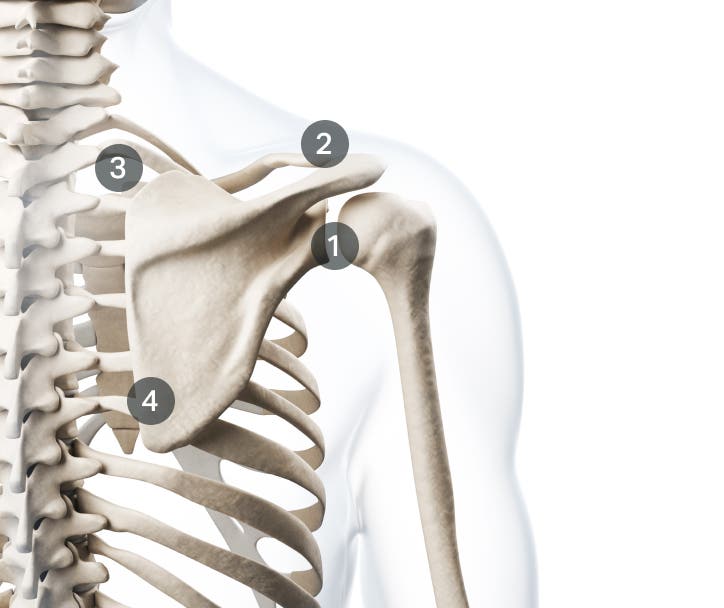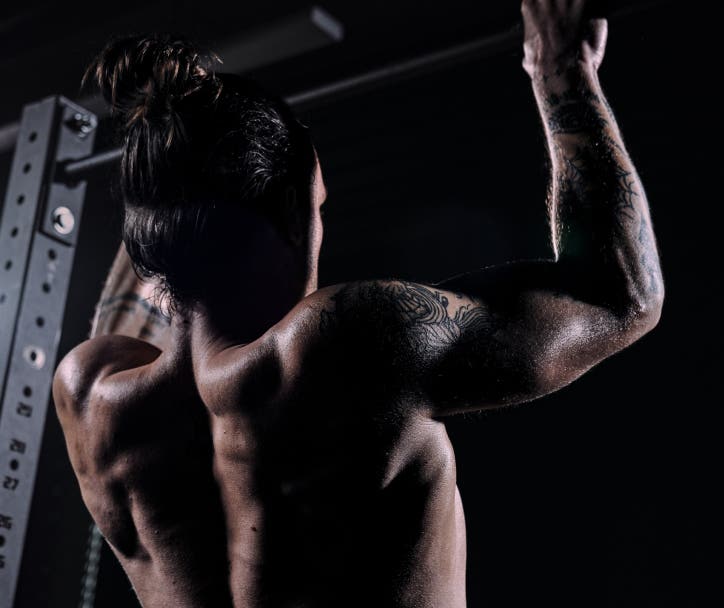Your shoulders can be either a source of joy or misery. If you put in the work, take care of them, and train properly, you’ll reap the rewards and eventually be able to show off your boulder shoulders—if that’s your goal.
On the other hand, skipping too many pushing exercises that target your shoulders can result in stiffness, discomfort, and reduced mobility. Nobody has time for that kind of setback, so let’s dive into how to build stronger shoulders.
What are the main muscles of the shoulder?
The shoulder, known for its complexity and extensive range of motion, relies on several muscles to facilitate movement and provide stability.
These muscles can be broken down into two categories:
- Muscles near the surface of your body, such as your chest and lat muscles
- Deeper muscles that are closer to the shoulder joint itself, such as your rotator cuff

In addition to the different shoulder muscles, there are also multiple joints that make up the shoulder joint:
- The joint between the upper arm and the shoulder socket
- The joint between the upper corner of the shoulder blade and the clavicle
- The joint between the clavicle and the sternum
- The joint between the shoulder blade and our ribcage

How do the shoulder muscles function?
To achieve a wide range of movements in the arm and shoulder, we need a variety of muscles that provide different functions. Consider the following movements, for example:
- Rotating the upper arm to the inside: chest, lat, and internal rotator muscles
- Rotating the upper arm to the outside: external rotator muscles
- Raising the arm to the front: chest muscles, front of the deltoid muscle, rotator cuff
- Raising the arm out to the side: side of the deltoid muscle, rotator cuff
- Pulling the arm to the back: lat muscle, back of the deltoid muscle, rotator cuff
And while different muscle groups are responsible for different movements, the rotator cuff is the glue that holds it together providing stability during all shoulder movements. It may not be visible during that mirror flex, but the rotator cuff is vital to your shoulder's health.
Another key shoulder muscle group is the one that moves your shoulder blades. A great way to visualize this is to think of the shoulder blades like the wings of a bird. In the front, the serratus muscles help bring the shoulder blades out and forward, such as when rounding your shoulders or crossing your arms in front. The rhomboids, located between your shoulder blades, contract the shoulder blades back together. Imagine pushing your chest out and trying to pinch a tennis ball between your shoulder blades. Having a good range of motion in all directions is essential for arm stability and preventing stiffness.
Why should you train your shoulders?
Shoulders may be small, but their impact on your performance and everyday life is mighty. Whether you’re lifting groceries or your child, the shoulder joint and supporting muscles play a significant role in stability and staying injury-free.
If you want your shoulders to remain powerful and pain-free as you age, you should prioritize training them. Of course, if you just want your shoulders to look good, we’re all for it.
In terms of shoulder health, the rotator cuff muscles should be at the forefront of your training. For aesthetics, you’ll also want to incorporate exercises that target the deltoids, or the muscles closer to the surface.
Regardless of your training preferences, there’s one simple fact to keep in mind: if you want to train long-term, you need to build healthy shoulders. But don’t worry—it’s not an either/or, and you don’t have to choose between health and aesthetics. For good-looking, healthy shoulders, you can have your cake and eat it too.

The best exercises for your shoulder muscles
In order to optimize your shoulder training, target your shoulders from a variety of angles. Push at an incline, decline, and over your head. Raise your arms laterally. Pull yourself both vertically and horizontally. That way, you’ll get the biggest bang for your buck, hitting all the muscles in your shoulder, plus those oh-so-important rotator cuff muscles.
Mix it up and combine different exercises such as Incline Bench Presses, Dips, and Overhead Presses for the front of your shoulders, and exercises such as Pullups, Rows, and Face Pulls for the rear of your shoulders. Add some Lateral Raises, and – check! – you’ve got all angles covered.
It’s also beneficial to incorporate different types of resistance tools, such as Dumbbells and Kettlebells, to hit your muscles in different ways. These tools can help increase your range of motion, plus certain exercises also require the recruitment of additional muscles, or stabilizers, to help keep your joints stable and maintain proper form as you perform the movement.
Barbells are another great option to get your shoulders pumping. You might even be able to go a little heavier as the range of motion is more restricted than with Dumbbells or Kettlebells.
If you’re a newbie to fitness, resistance bands are an excellent tool for beginners. Use Banded Reverse Flys and Lateral Raises to build up some strength and stability before you progress to more advanced shoulder exercises.
If you can’t get your hands on some weights or you prefer using your body weight, Dips and Pullups are another great option. If you struggle with these movements, feel free to use a resistance band to assist and get after it.
However you choose to train, opt for mixing it up to maximize your results, and do what works for you!
How to care for your shoulders
An important factor when it comes to shoulder health is mobility, or how far you can freely move your arms in any direction. If you’re struggling with mobility, there are two types of exercises you can focus on.
First, active exercises that require you to stabilize at different angles, such as a Turkish Getup (TGU). Second, exercises that help you reach end ranges, such as Passive Hang and Dips. If you feel that these exercises are simply not in the cards for you (yet!), prioritize shoulder stretches that target different angles to help build up strength.
Likewise, keep in mind that your shoulders are also influenced by your upper back and your torso's mobility. You can use a foam roller to help loosen any tension in your lats and upper back, and a myofascial ball or tennis ball to get those hard-to-reach areas of tension around your shoulder blades, shoulder, and chest. Combining self-myofascial release methods before performing stretches such as the Cobra, Deep Squat Rotations, and Windmills can help you build mobility there, which translates to your ability to move your arms behind your back or over your head.
When stretching your shoulders, make sure to use controlled movements and a good range of motion. Don’t force movement that is not there (yet), and take your time while progressing your shoulder mobility. Slow and steady wins the race.
Let’s recap
To build strong and healthy shoulders, you need to train them both inside and out. Pull and push from all angles, add some resistance, and mix it up to work all of the different muscles. Don’t forget to give your shoulders a little R&R with a combination of mobility exercises and gentle stretches. If you keep your shoulders healthy, they’ll keep you in action – and that’s what long-term fitness is all about.